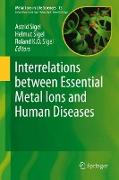- Start
- Interrelations between Essential Metal Ions and Human Diseases
Interrelations between Essential Metal Ions and Human Diseases
Angebote / Angebote:
MILS-13 provides an up-to-date review on the relationships between essential metals and human diseases, covering 13 metals and 3 metalloids: The bulk metals sodium, potassium, magnesium, and calcium, plus the trace elements manganese, iron, cobalt, copper, zinc, molybdenum, and selenium, all of which are essential for life. Also covered are chromium, vanadium, nickel, silicon, and arsenic, which have been proposed as being essential for humans in the 2nd half of the last century. However, if at all, they are needed only in ultra-trace amounts, and because of their prevalence in the environment, it has been difficult to prove whether or not they are required. In any case, all these elements are toxic in higher concentrations and therefore, transport and cellular concentrations of at least the essential ones, are tightly controlled, hence, their homeostasis and role for life, including deficiency or overload, and their links to illnesses, including cancer and neurological disorders, are thoroughly discussed. Indeed, it is an old wisdom that metals are indispensable for life. Therefore, Volume 13 provides in an authoritative and timely manner in 16 stimulating chapters, written by 29 internationally recognized experts from 7 nations, and supported by more than 2750 references, and over 20 tables and 80 illustrations, many in color, a most up-to-date view on the vibrant research area of the Interrelations between Essential Metal Ions and Human Diseases.Astrid Sigel, Helmut Sigel, and Roland K. O. Sigel have long-standing interests in Biological Inorganic Chemistry. Their research focuses on metal ion interactions with nucleotides and nucleic acids and on related topics. They edited previously 44 volumes in the series Metal Ions in Biological Systems.
Folgt in ca. 15 Arbeitstagen
